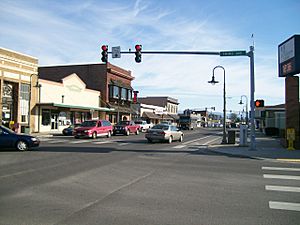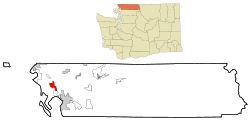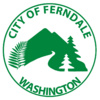Ferndale, Washington facts for kids
Quick facts for kids
Ferndale, Washington
|
||
|---|---|---|

Downtown Ferndale
|
||
|
||

Location of Ferndale, Washington
|
||
| Country | United States | |
| State | Washington | |
| County | Whatcom | |
| Incorporated | March 19, 1907 | |
| Government | ||
| • Type | Mayor–council | |
| Area | ||
| • City | 7.14 sq mi (18.49 km2) | |
| • Land | 7.03 sq mi (18.20 km2) | |
| • Water | 0.11 sq mi (0.27 km2) | |
| Elevation | 36 ft (11 m) | |
| Population
(2020)
|
||
| • City | 15,048 | |
| • Estimate
(2023)
|
15,992 | |
| • Density | 2,276/sq mi (878.8/km2) | |
| • Metro | 231,919 (US: 204th) | |
| • Metro density | 109.4/sq mi (42.25/km2) | |
| Demonym(s) | Ferndaler, Ferndalian |
|
| Time zone | UTC–8 (Pacific (PST)) | |
| • Summer (DST) | UTC–7 (PDT) | |
| ZIP Code |
98248
|
|
| Area code(s) | 360, 564 | |
| FIPS code | 53-23620 | |
| GNIS feature ID | 1512205 | |
Ferndale is a city in Whatcom County, Washington, USA. In 2020, about 15,048 people lived there. By 2023, the population grew to an estimated 15,992.
Ferndale is the third largest city in Whatcom County. It is located near the Lummi Nation. It's also part of the larger Bellingham metropolitan area.
Discovering Ferndale: A Look at Its Past
How Ferndale Got Its Name
Long ago, the Lummi Nation had a settlement in the Ferndale area. Early European settlers called this spot the "lower crossing" of the Nooksack River. This was different from another main river crossing at Everson.
The first European to live here full-time was Billy Clark. He was from Texas and came during the Gold Rush. He lived in Ferndale with his family for over ten years.
The area was first settled in 1872. It was originally called "Jam" because of a large log jam on the Nooksack River. But the first schoolteacher thought it needed a prettier name. She noticed the many ferns growing around the schoolhouse. So, she suggested the name "Ferndale." The city officially became a town on March 19, 1907.
Exploring Ferndale's Location and Weather
Where is Ferndale?
Ferndale covers about 7.14 square miles (18.49 square kilometers). Most of this area is land, with a small part being water.
The downtown area of Ferndale is close to the Nooksack River. There's also an industrial area east of the river. As you move northwest, you'll find many suburban neighborhoods. Ferndale is also next to Hovander Homestead Park and Tennant Lake. These are located along its southeast border.
Ferndale's Climate: What's the Weather Like?
Ferndale has a mild climate. This means it doesn't get too hot or too cold. The average monthly temperatures never go above 71.6°F (22°C).
While Ferndale can be a bit windier, its temperatures, cloudiness, and rainfall are similar to nearby towns. These include Bellingham and Lynden. Ferndale usually gets a little less snow than Lynden.
People and Population in Ferndale
How Many People Live in Ferndale?
| Historical population | |||
|---|---|---|---|
| Census | Pop. | %± | |
| 1910 | 691 | — | |
| 1920 | 759 | 9.8% | |
| 1930 | 752 | −0.9% | |
| 1940 | 717 | −4.7% | |
| 1950 | 979 | 36.5% | |
| 1960 | 1,442 | 47.3% | |
| 1970 | 2,164 | 50.1% | |
| 1980 | 3,855 | 78.1% | |
| 1990 | 5,398 | 40.0% | |
| 2000 | 8,758 | 62.2% | |
| 2010 | 11,415 | 30.3% | |
| 2020 | 15,048 | 31.8% | |
| 2023 (est.) | 15,992 | 40.1% | |
| U.S. Decennial Census 2020 Census |
|||
In 2020, Ferndale had 15,048 people living in 5,385 households. About 3,911 of these were families. The city had about 2,142 people per square mile (827 per square kilometer).
Most people in Ferndale identified as White (about 71.6%). Other groups included Asian (6.8%), Native American (2.5%), Black (1.1%), and Pacific Islander (0.6%). About 10.3% of people identified with two or more races. Also, 14.8% of the population was Hispanic or Latino.
A Look Back: Ferndale in 2010
In 2010, Ferndale had 11,415 people. There were 4,210 households. About 40.8% of these households had children under 18. Most households (53.7%) were married couples.
The average age in Ferndale was 34.2 years. About 29.1% of residents were under 18. About 10.9% were 65 or older. The city had slightly more females (51.4%) than males (48.6%).
Ferndale's Economy: How People Make a Living
Ferndale's economy started with timber (wood) and farming. Later, dairy processing became a big employer. The old Carnation dairy plant is now used for offices.
In the 1950s, the Ferndale Refinery was built. This caused the town's population to grow a lot. Another refinery, the Cherry Point Refinery, was built in the 1970s.
A company called Brooks Sports has a shoe factory in Ferndale. It can make 500,000 pairs of shoes each year! Ferndale is also a "bedroom community" for Bellingham. This means many people who live in Ferndale travel to Bellingham for work.
-
Rail bridge over the Nooksack River
Getting Around Ferndale: Transportation
The main highway that goes through Ferndale is Interstate 5. This is a major road for cars and trucks.
The town also has BNSF Railway tracks. These tracks are used for freight (carrying goods). They also carry Amtrak Cascades passenger trains, which means people can travel by train.
Ferndale's Sister City
Ferndale has a special friendship with another city far away. This is called a sister city relationship.
 Minamibōsō, Chiba Prefecture, Japan.
Minamibōsō, Chiba Prefecture, Japan.
Famous People from Ferndale
Many talented people have come from Ferndale! Here are a few:
- Jesse Brand – A songwriter, musician, and actor.
- Dennis Erickson – A retired football coach for colleges and the NFL.
- Sky Hopinka – A filmmaker, poet, and artist who won a special grant.
- Michael Koenen – A former punter for the Tampa Bay Buccaneers football team.
- Jake Locker – A former NFL quarterback for the Tennessee Titans.
- Daran Norris – An actor known for his voice work and roles on TV shows like Veronica Mars.
- Doug Pederson – A former NFL quarterback and head coach of the Jacksonville Jaguars.
- Wendy B. Lawrence – A former NASA astronaut and captain in the US Navy.
See also
 In Spanish: Ferndale (Washington) para niños
In Spanish: Ferndale (Washington) para niños




